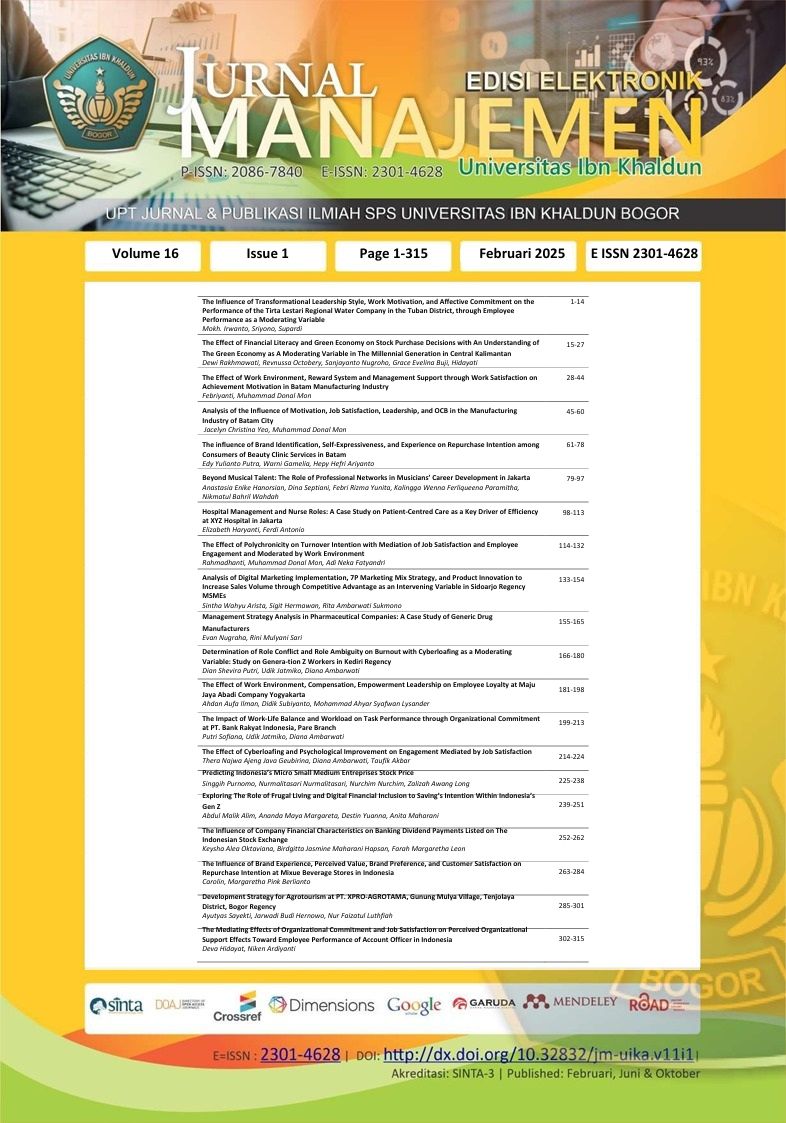The Influence of Brand Experience, Perceived Value, Brand Preference, and Customer Satisfaction on Repurchase Intention at Mixue Beverage Stores in Indonesia
DOI:
https://doi.org/10.32832/jm-uika.v16i1.17759Keywords:
Brand Experience, customer satisfaction, Brand Preference, Perceived Value, Repurchase IntentionAbstract
This study examines the influence of brand experience, perceived value, brand preference, and customer satisfaction on repurchase intentions within the competitive landscape of the international beverage market, focusing on Mixue's operations in Indonesia. Amidst the challenges of globalization, where emotional and psy-chological customer responses significantly affect purchasing de-cisions and brand loyalty, this research aims to delineate the fac-tors critical to consumer retention strategies. Utilizing a quantita-tive approach, data were collected from 163 respondents in the Greater Jakarta area, all of whom had recent transactions with Mixue. The analysis, conducted using the Partial Least Square Structural Equation Model (PLS-SEM), demonstrates that brand experience, perceived value, brand preference, and customer sat-isfaction each significantly enhance repurchase intentions. These findings underscore the importance of sensory and emotional en-gagement in improving brand perception and satisfaction, which are pivotal in driving customer loyalty and repeat business. Con-sequently, the study suggests that beverage companies should fo-cus on optimizing these elements through strategic sensory brand-ing and reasonable pricing to bolster brand preference and sus-tain growth in a highly competitive environment.
References
Afinia, S. (2024). The impact of customer satisfaction on repurchase intention in e-commerce: a study in indonesia. Jurnal Mantik, 8(1), 724–733. https://doi.org/10.35335/mantik.v8i1.5206
Ajzen, I. (1991). The theory of planned behavior. Organizational Behavior and Human Decision Pro-cesses, 50(2), 179–211. https://doi.org/10.1016/0749-5978(91)90020-T
Anderson, R. E., & Srinivasan, S. S. (2003). E‐satisfaction and e‐loyalty: A contingency framework. Psychology & Marketing, 20(2), 123–138. https://doi.org/10.1002/mar.10063
Andreini, D., Pedeliento, G., Zarantonello, L., & Solerio, C. (2018). A renaissance of brand experi-ence: Advancing the concept through a multi-perspective analysis. Journal of Business Research, 91, 123–133. https://doi.org/10.1016/j.jbusres.2018.05.046
Angeline, G. (2023). The Influence of Brand Experience and Perception Quality on Brand Loyalty Mediated by Brand Trust (Empirical Study: Mixue Consumers in Jakarta). Asian Journal of Social and Humanities, 2(03). https://doi.org/10.59888/ajosh.v2i03.150
Bandura, A. (1986). Social Foundations of Thought and Action: A Social Cognitive Theory. Prentice Hall.
Bougie, R., & Sekaran, U. (2019). Research Methods For Business: A Skill Building Approach, 8th Edition (8th ed.). Wiley.
Brilliant, M. A., & Achyar, A. (2014). The Impact of Satisfaction and Trust on Loyalty of E-Commerce Customers. ASEAN Marketing Journal, 5(1). https://doi.org/10.21002/amj.v5i1.2175
Chen, C.-F., & Chang, Y.-Y. (2008). Airline brand equity, brand preference, and purchase inten-tions—The moderating effects of switching costs. Journal of Air Transport Management, 14(1), 40–42. https://doi.org/10.1016/j.jairtraman.2007.11.003
Chen, C.-F., & Tsai, M.-H. (2008). Perceived value, satisfaction, and loyalty of TV travel product shopping: Involvement as a moderator. Tourism Management, 29(6), 1166–1171. https://doi.org/10.1016/j.tourman.2008.02.019
Curtis, T., Abratt, R., Rhoades, D. L., & Dion, P. (2011). Customer Loyalty, Repurchase and Satis-faction: A Meta-Analytical Review. In Journal of Consumer Satisfaction, Dissatisfaction and Com-plaining Behavior.
DAM, T. C. (2020). Influence of Brand Trust, Perceived Value on Brand Preference and Purchase Intention. The Journal of Asian Finance, Economics and Business, 7(10), 939–947. https://doi.org/10.13106/jafeb.2020.vol7.no10.939
Deci, E. L., & Ryan, R. M. (2000). The “What” and “Why” of Goal Pursuits: Human Needs and the Self-Determination of Behavior. Psychological Inquiry, 11(4), 227–268. https://doi.org/10.1207/S15327965PLI1104_01
Ebrahim, R., Ghoneim, A., Irani, Z., & Fan, Y. (2016a). A brand preference and repurchase intention model: the role of consumer experience. Journal of Marketing Management, 32(13–14), 1230–1259. https://doi.org/10.1080/0267257X.2016.1150322
Ebrahim, R., Ghoneim, A., Irani, Z., & Fan, Y. (2016b). A brand preference and repurchase inten-tion model: the role of consumer experience. Journal of Marketing Management, 32(13–14), 1230–1259. https://doi.org/10.1080/0267257X.2016.1150322
Garson, G. D. (2016). Partial Least Squares: Regression and Structural Equation Models. Statistical Associates Publishers.
Ghozali, I., & Latan, H. (2015). Partial least squares konsep, teknik dan Aplikasi Menggunakan Pro-gram SmartPLS 3.0 untuk penelitian empiris (4th ed.). Badan Penerbit UNDIP.
Giró Manzano, P. (2021). CUSTOMER SATISFACTION MEASUREMENT Strategies, methodologies and factors influencing customer satisfaction measures.
Hair, J., Hult, G. T. M., Ringle, C., & Sarstedt, M. (2022). A Primer on Partial Least Squares Struc-tural Equation Modeling (PLS-SEM).
Hair, Risher, J. J., Sarstedt, M., & Ringle, C. M. (2019). When to use and how to report the results of PLS-SEM. European Business Review, 31(1), 2–24. https://doi.org/10.1108/EBR-11-2018-0203
Halim, E., Hebrard, M. T., Laurent, C., & Kurniawan, Y. (2022). The Impact of Customer Satisfac-tion and Customer Trust to Repurchase Intention in Purchasing Digital Product at the Marketplace. 2022 International Seminar on Intelligent Technology and Its Applications (ISITIA), 181–186. https://doi.org/10.1109/ISITIA56226.2022.9855299
Han, H., Lee, K.-S., Song, H., Lee, S., & Chua, B.-L. (2019). Role of coffeehouse brand experiences (sensory/affective/intellectual/behavioral) in forming patrons’ repurchase intention. Journal of Hospi-tality and Tourism Insights, 3(1), 17–35. https://doi.org/10.1108/JHTI-03-2019-0044
Hennig-Thurau, T., & Hansen, U. (2000). Relationship Marketing: Gaining Competitive Advantage Through Customer Satisfaction and Customer Retention. https://doi.org/10.1007/978-3-662-09745-8
Iglesias, O., Singh, J. J., & Batista-Foguet, J. M. (2011). The role of brand experience and affective commitment in determining brand loyalty. Journal of Brand Management, 18(8), 570–582. https://doi.org/10.1057/bm.2010.58
Khan, I., Rahman, Z., & Fatma, M. (2016). The role of customer brand engagement and brand expe-rience in online banking. International Journal of Bank Marketing, 34, 1025–1041. https://api.semanticscholar.org/CorpusID:168331648
Kim, L., Chouykaew, T., Pongsakornrungsilp, S., Jindabot, T., & Lee, S. (2023). How to promote repurchase intention toward Covid-19 antigen test kits: Evidence from Thai consumers. Innovative Marketing, 19(1), 186–196. https://doi.org/10.21511/im.19(1).2023.16
Maharani, A. S. A., & Alexander, H. B. (2023, January 5). Gerai Mixue Merajalela, Mengisi Ruko-ruko Kosong, Terbanyak di Jawa Barat. Kompas.Com. https://www.kompas.com/properti/read/2023/01/05/080000121/gerai-mixue-merajalela-mengisi-ruko-ruko-kosong-terbanyak-di-jawa-barat?page=all
Maulida, W. U., Andari, T. T., & Yulianingsih, Y. (2024). Pengaruh Brand Trust, Customer Value dan Customer Experience terhadap Customer Satisfaction pada CV. Syifa Adventure. AKADEMIK: Jurnal Mahasiswa Ekonomi & Bisnis, 4(3), 1023–1035. https://doi.org/10.37481/jmeb.v4i3.858
Oliver, R. L. (1999). Whence Consumer Loyalty? Journal of Marketing, 63(4_suppl1), 33–44. https://doi.org/10.1177/00222429990634s105
Pambudi, R., Manggabarani, A. S., Supriadi, Y. N., & Setiadi, I. K. (2024). Boosting repurchase rates in B2C e-commerce: the role of customer satisfaction and relationship factors. Multidisciplinary Sci-ence Journal, 7(3), 2025096. https://doi.org/10.31893/multiscience.2025096
Pham, L. D. Q., Coles, T., Ritchie, B. W., & Wang, J. (2021). Building business resilience to exter-nal shocks: Conceptualising the role of social networks to small tourism & hospitality business-es. Journal of Hospitality and Tourism Management, 48, 210–219. https://doi.org/10.1016/j.jhtm.2021.06.012
Piercy, N. F., & Morgan, N. A. (1995). Customer satisfaction measurement and management: A pro-cessual analysis. Journal of Marketing Management, 11(8), 817–834. https://doi.org/10.1080/0267257X.1995.9964393
Priadi, A. F., & Lestari, F. (2024). Product Quality and Brand Trust Analysis on Customer Loyalty at Zetqlo Apparel in Bandung City. Banking & Management Review, 12(2), 119–130. https://doi.org/10.52250/bmr.v12i2.815
Reichheld, F., & Schefter, P. (2000). E-Loyalty: Your Secret Weapon on the Web. Harvard Business Review, 78.
Sarstedt, M., Hair, J. F., Pick, M., Liengaard, B. D., Radomir, L., & Ringle, C. M. (2022). Progress in partial least squares structural equation modeling use in marketing research in the last decade. Psy-chology & Marketing, 39(5), 1035–1064. https://doi.org/10.1002/mar.21640
Sarstedt, M., Hair, J. F., & Ringle, C. M. (2023). “PLS-SEM: indeed a silver bullet” – retrospective observations and recent advances. Journal of Marketing Theory and Practice, 31(3), 261–275. https://doi.org/10.1080/10696679.2022.2056488
Sun, C., Su, S., & Huang, J. (2013). Cultural value, perceived value, and consumer decision‐making style in China. Nankai Business Review International, 4(3), 248–262. https://doi.org/10.1108/NBRI-07-2013-0026
Sweeney, J. C., & Soutar, G. N. (2001). Consumer perceived value: The development of a multiple item scale. Journal of Retailing, 77(2), 203–220. https://doi.org/10.1016/S0022-4359(01)00041-0
Tiofani, K., & Agmasari, S. (2022, December 29). Sejarah Mixue, Toko Es Krim yang Menjamur di Indonesia. Kompas.Com. https://www.kompas.com/food/read/2022/12/29/121000775/sejarah-mixue-toko-es-krim-yang-menjamur-di-indonesia
Trusov, M., Bucklin, R. E., & Pauwels, K. (2009). Effects of Word-of-Mouth versus Traditional Marketing: Findings from an Internet Social Networking Site. Journal of Marketing, 73(5), 90–102. https://doi.org/10.1509/jmkg.73.5.90
Wijayanti, R. I. (2023, January 2). Berapa Jumlah Gerai Mixue di Indonesia? Franchise Es Krim yang Kini Menjamur. Milenomic. https://www.idxchannel.com/milenomic/berapa-jumlah-gerai-mixue-di-indonesia-franchise-es-krim-yang-kini-menjamur
Zeithaml, V. A. (1988). Consumer Perceptions of Price, Quality, and Value: A Means-End Model and Synthesis of Evidence. Journal of Marketing, 52(3), 2–22. https://doi.org/10.1177/002224298805200302
Zikmund, W., Carr, B., Griffin, M., Babin, B., & Carr, J. (2013). Business Research Method.
Downloads
Published
How to Cite
Issue
Section
License
Copyright (c) 2024 Jurnal Manajemen

This work is licensed under a Creative Commons Attribution-NonCommercial 4.0 International License.
Authors who publish with this journal agree to the following terms:
- Authors retain copyright and grant the journal right of first publication with the work simultaneously licensed under a Creative Commons Attribution-NonCommercial-ShareAlike 4.0 International License that allows others to share the work with an acknowledgement of the work's authorship and initial publication in this journal.
- Authors can enter into separate, additional contractual arrangements for the non-exclusive distribution of the journal's published version of the work (e.g., post it to an institutional repository or publish it in a book), with an acknowledgement of its initial publication in this journal.
- Authors are permitted and encouraged to post their work online (e.g., in institutional repositories or on their website) prior to and during the submission process, as it can lead to productive exchanges, as well as earlier and greater citation of published work (See The Effect of Open Access).











